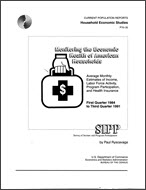Monitoring the Economic Health of American Households
Monitoring the Economic Health of American Households
A Note to Users
All demographic surveys, including SIPP, are affected by undercoverage of the population. This undercoverage results from missed housing units and missed persons with sample households. Compared to the level of the 1980 decennial census, overall undercoverage is about 7 percent. Undercoverage varies with age, sex, and race. For some groups, such as 20 to 24 year old Black males, the undercoverage is as high as about 35 percent. The weighting procedures used by the Census Bureau partially correct for the bias due to undercoverage. However, its final impact on estimates is unknown.
Introduction
Since 1983 the Census Bureau has been collecting information on the incomes and other economic, social, and demographic characteristics of our Nation's households on a subannual basis in its Survey of Income and Program Participation (SIPP). The statistics from this survey have provided policy makers, researchers, and the general public with new and important insights into specific aspects of the economic well-being of Americans. For example, they have been used to better understand the relationship between poverty and participation in Federal government transfer programs, to identify individuals receMng benefits from multiple income transfer programs, and to learn more about those persons not covered by health insurance.1
The SIPP, however, can also be used to monitor the general economic well-being of households across fairly long periods of time. This is because the SIPP is an ongoing and recurring survey of the same individuals over time and, unlike other surveys, the information collected relates to a much wider range of activities which people engage in that ultimately determine their economic well-being.
Up until the development of SIPP, most Federal government stati'Stical surveys have been subject specific. That is, they focused on aspects of the economic well-being of our population: health, employment and unemployment, housing, jobs, and so on. Policy makers who attempted to assess how well society was faring economically had to assemble data from a variety of sources before making judgements and reaching decisions. While the data collected in the SIPP do not represent all of the activities which determine economic well-being, the data do reflect the activities of individuals in relation to two important sources of economic well-being in contemporary America—the labor market and the Federal government.
In the last quarter of the 20th century, economic life in this country, as in all major industrialized countries, has become considerably more complex. One way it has become more complex is with respect to our relationship to the job market and to the Federal government. Economic well-being today does not simply depend on whether one has a job or not, for example, but whether it pays well and what kind of benefits are provided, such as health insurance. It also can depend on the availability of social welfare programs—the "social welfare net"—and their beneficence in times of unemployment, illness, and old age. For many American households today, economic well-being depends on this interrelationship between the labor market and their Federal, State, and local governments, or more broadly speaking, the private and the public sectors of society.
The following report contains subannual data relating to the economic well-being of households, families, and persons during most of the 1980s and early 1990s. Specifically, average monthly estimates are presented for
- the incomes of households,
- the labor force activity of persons,
- the Federal government program participation of individuals and households,
- and the health insurance coverage of the population,
during the period from the first quarter of 1984 to the third quarter of 1991. (Also included in this report are data for the period from the fourth quarter of 1991 to the third quarter of 1992. These data, however, are not analyzed as they only became available after the main body of this report was completed.)
During this period the Nation's economy was in two different stages of the business cycle. Economic expansion characterized most of the 1980s, specifically from November 1982 to July 1990; economic contraction characterized the 1990 to 1991 period, specifically from July 1990 to March 1991.2 SIPP's unique capability, therefore, is to monitor how households fared during these periods of economic expansion and contraction and to observe the relationship between the private and public sectors as sources of economic well-being.3
_______________
1 Other descriptive reports have also related to various aspects of the economic well-being of persons, families, and households, for example, household wealth and asset ownership, transitions into and out of poverty, spells of job search, and disability.
2 Turning points of the business cycle (peaks and troughs) are identified by the National Bureau of Economic Research.
3 In the early 1990s, the Census Bureau asked the Committee on National Statistics of the National Academy of Sciences to convene a panel of experts to make a review of the SIPP—its goals, its sample design, its data products, and so on—for the purposes of helping the Bureau enhance the utility and cost effectiveness of the SIPP. This resulted in the report, The Future of the Survey of Income and Program Participation, National Research Council, (Washington, DC: National Academy Press), 1993.
Others in Series
Publication
Publication
Publication




